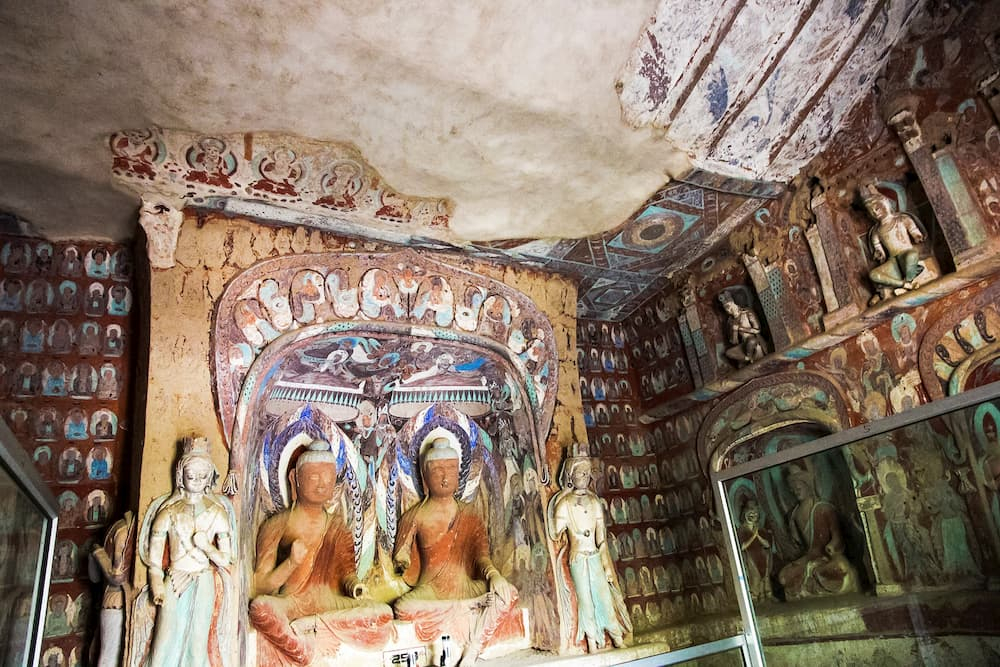
Dunhuang Art
Splendid
Chi Culture
Topic
Dunhuang Art
The name Dunhuang is composed of two characters. The first, “dun,” means large or big; the second, “huang,” means to flourish or to thrive. Only these robust words can accurately describe this magical land. Dunhuang covers 31,200 square kilometers. In the south it rests on the imposing Qiliang mountain range; in the west it connects with Lop Nor; in the north it approaches the rugged Beisai Mountain; and, in the east it faces the towering rocky peaks of Sanwei Mountain. Dunhuang has a warm temperate climate with ample sunlight and long frost-free periods. In this small natural basin near the Gobi Desert, the spring snowmelt swells the waters of the Dang River which nourishes the fertile soil. Thick and shadowy green trees block the wind and yellow sand. The grain and cotton crops, despite flooding or drought, are regularly harvested. Melons and fruits perfume the air throughout the year. The Gobi Desert is unpredictable and the mirages seen there are described as grotesque and fantastic. While the cultural relics found in the region are world famous, the society is stable and the people are simple and unsophisticated. All in all, it is a remarkable place that has continuously produced men of talent. Together, these features compose a mysterious and splendid region and attract travelers from throughout the world.
Dunhuang has a long history and a brilliant culture. Early on, the Sanmiao people were defeated in battle and forced to leave the Central Plain region. They moved west of the Yellow River where they built communities and prospered. They survived mainly by hunting but also began to master primitive agricultural techniques. Neolithic relics such as stone knives, axes, pottery, and bronzeware have been unearthed in the area. During the Xia (ca. 2100–ca. 1600 BCE), Shang (ca. 1600–ca. 1100 BCE), and Zhou (ca. 1100–256 BCE) dynasties, Dunhuang was under the jurisdiction Guazhou (modern Dunhuang city). Descendants of the Sanmiao tribe, known at this time as the Qiang and the Rong, resided here as nomads. Many of the rock paintings left behind by the nomads are still clearly visible.
Dunhuang reached its golden age during the Han (206 BCE–220 CE) and Tang (618–907) dynasties, when the area was transformed by a splendid culture. Historical sites are everywhere: the Mogao Caves, the Yulin Caves, and the West Qianfo Caves. The Mogao Caves, also known as the Dunhuang Caves, have always been called the “pearl of Asian art.” It is the largest cave network and covers more than one thousand years of history through ten dynasties. There are 492 grottoes, more than forty-five thousand square meters of murals and more than two thousand polychrome statues. Most of the images come from Buddhist stories, but there are some murals that depict folk customs, farming, weaving, hunting, weddings, funerals, and holiday festivities.
In the mid-Tang (ca. mid-eighth century), Dunhuang was occupied by the Tubo people for nearly seventy years. During this time, the Tubo repaired and completed many grottoes and murals which had been left unfinished because of wars. Meanwhile, the Tubo rulers continued to carve new grottoes, and greatly enrich the contents and images of the murals, including images of Tibetan Buddhism. Dunhuang murals have always enjoyed a high reputation, inspiring people to say “a thousand years of Dunhuang murals are unsurpassed masterpieces.” They are rich and colorful and mostly illustrate divinities and their interactions with one another and the mortal realm.
The murals and polychrome statues were fashioned with unparalleled technique. The muralists at Dunhuang were not concerned about the wall’s texture—they would, and could, paint on any surface. Under the painter’s brush, even the minutest details are distinctive. The murals in the Mogao Caves alone cover more than forty-five thousand square meters (ca. seven standard soccer fields). The contents of the murals fall into several categories: portraits of the Buddha and Buddhist pantheon, story paintings, illustrations of transformation texts (bianwen), historical Buddhist events, and donor’s portraits. Non-Buddhist paintings cover a broad variety of themes: people, landscapes, birds and flowers, political events, economy, military affairs, technology, cultural affairs, religious beliefs, and cultural exchanges between China and the West. Life in former times comes alive in the paintings; they are no different from a historical encyclopedia.
An important artistic value of Dunhuang lies in its continuous development—it continued to grow through ten dynasties and nearly one thousand years. Although we are unable to see the original caves created during the Former Qin era (351–394), the story of Lezun—the monk who built the first grotto at Mogao—remains a beautiful and magical legend. Fortunately, the relics preserved in the Mogao Caves clearly demonstrate their evolution from the Northern Wei dynasty (386–534) through the Yuan dynasty (1271–1368). Entering the caves, visitors read the walls as if they were books, noting the resourceful residents that lived through turbulent and horrifying wars of the Northern Dynasties (386–581), and who integrated Western Regions style with the vigorous style of the Wei-Jin era (220–420). They see that the people who lived through the golden age of the Tang were elegant and poised as they calmly and self-assuredly pursued artistic perfection. During the Five Dynasties (907–960) and the Northern Song period (960–1127), when the region began to decline, the people lost the courage to forge ahead. It was the vitality and valor of the Mongols, who founded the Yuan dynasty) that brings a final pleasant surprise.




